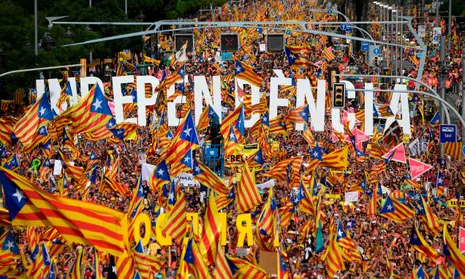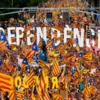Seats of the Generalitat, Catalonia's regional government
If you've followed events in Spain in recent years, you've probably been aware of a strong independence movement in Catalonia, including an attempted referendum and declaration of independence that were forcibly suppressed, and whose aftermath is still simmering.
Barcelona's Museum of the History of Catalonia is a good place to start if you're curious why Catalonia is home to such strong sentiment for either independence from Spain or much greater autonomy from the central government. And, in a way the museum helps promote that sentiment: its permanent exhibition is titled "The Memory of a Country."
Its home is on the Barcelona waterfront, in the Palau de Mar, or Sea Palace. The building, originally a huge warehouse, is the last remaining building of the city's old industrial waterfront. It was established in 1996 by the Catalan government as part of an effort to make Catalonia's history and culture better known.
Its home is on the Barcelona waterfront, in the Palau de Mar, or Sea Palace. The building, originally a huge warehouse, is the last remaining building of the city's old industrial waterfront. It was established in 1996 by the Catalan government.
Like almost every other place in Europe, its history starts in pre-history. The exhibit starts with an introductory section based on archaeological discovery and other ancient evidence.
But it moves on fairly quickly to evidences of Greek colonization and trade, and then the arrival of the Romans, followed after a few centuries by Goths and Visigoths. The tactile map below shows, outlined in white, the Roman town of Barcino that grew to become Barcelona.
But a trip through the museum makes clear one of the driving engines of Catalan nationalism and the push to preserve Catalonia's language and culture: Over the centuries, it's been caught in the middle between powerful forces and powerful rivals that have repeatedly seemed to threaten its existence.
Fortifications and churches of the post-Roman era were built for an era of unrest and frequent battles
Its first existence as a distinct state, in the early 800s, came when Charlemagne's empire created the Spanish March as a buffer between the Islamic-ruled bulk of Spain and what is now France.
The four red stripes of the Catalan flag come from the arms of the Counts of Barcelona, supposedly originating from bloody fingers on a slain count's shield
Even as it grew and absorbed more of what is now Catalonia, it was always between those two forces, and then caught up in the power struggles as other Christianized parts of Spain contended with it for land and power.
Domestic life is depicted in exhibits alongside the ones showing the waxing and waning of Catalonia's power and territory
Eventually paired up with neighboring Aragon, it was a military and economic power—until Aragon turned to a union with Castile under Ferdinand of Aragon and Isabella of Castile (remember them?) and left Catalonia a stepchild as the newly united Spain turned to the Atlantic and froze Catalonia out of the new trade.
Internally, there was often strife as well. In 15th century, there was a civil war over succession to the throne that lasted ten years, as well as serf and peasant revolts over taxes. In the 1640s, there was a peasant revolt, called the Reapers' War, across Catalonia; it led to more struggle between Catalonia and its Aragonese partners. The song, Els Segadors (the Reapers) from that period is the 'national anthem' of Catalonia.
In the 18th and 19th centuries, starting with the textile industry, Catalonia became the first area of Spain to industrialize. Its newly wealthy industrial class, feeling marginalized from power, turned to a revival of Catalan language and literature, and to recreating a national identity, with its greatest flowering at the end of the 19th century.
But in the 20th century, under Franco, who wanted a single centralized Spanish power and identity, Catalonia's autonomy, language and institutions were repressed again, only to re-emerge in the 1970s after Franco's death. Today, Catalan independence or at least greater autonomy, is still very much the topic of the day.
The museum's exhibits of the 19th and early 20th century give great emphasis to the Catalan revival movements in both politics and literature and art. The photo display is of the founders of the Institute for Catalan Studies (Institut d'Estudis Catalans), founded in the early 1900s to standardize Catalan language and promote Catalan culture.
The 19th century also saw Barcelona burst out of its medieval walls (the section in black above) into one of Europe's first planned city expansions, the Eixample, whose regular streets, long diagonals and small squares at nearly every corner mark the city today. The Barcino area shown on the earlier map is in the center of the black area.
Early 20th century life and occupations are on display, including an interactive 'dress-up' section with clothing matching different ways of life.
Another section is full of photos, posters and other exhibits covering the period of the Spanish Civil War of 1936-39, followed by a series of exhibits highlighting Catalonia's industries today: it is still the most industrialized region of Spain.
This, by the way, not a fast museum to move through; the narration is much more dense than this article, and is in English as well as Catalan and Spanish. There's no museum cafe, but the waterfront area around it is filled with bars, cafes and patios.



Comments (0)